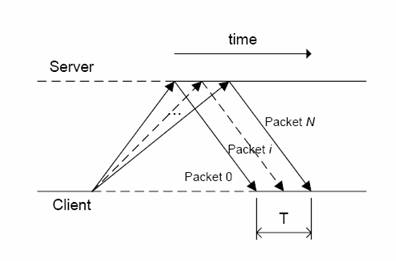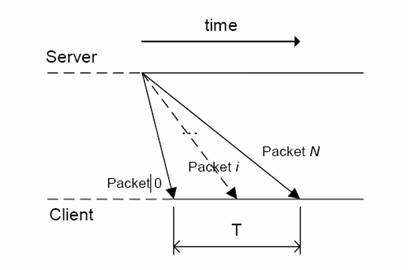Broadband Tests - Traffic Shaping
Our broadband speed test take into account that ATM traffic shaping has a goal of regulating the traffic flow as per the parameters describing the negotiated QoS to achieve better network efficiency. The basic idea of ATM traffic shaping is buffering the packets/cells and controlling, mostly delaying, their entry into the network, thereby ensuring a more constant flow of traffic in the network.
DSL Speed Test - Application to Asymmetric DSL Networks
The DSL Speed Test understands that the asymmetric nature of ADSL networks makes it necessary to have different measurements methodologies for upstream and downstream cases. The speed tests are based upon the assumption that the upstream bandwidth is lower than the downstream bandwidth.DSL Speed Test - Upstream methodology

A fixed number of UDP packets of uniform size are sent from the customer's computer (client) at a rate slightly higher than the nominal bottleneck bandwidth of the ADSL network during our DSL speed test. Probing traffic with the slightly higher rate (e.g., less than 10%) is necessary to saturate the pipe for testing. A server process on the Bandwidth Measurement Server, echoes back the packets as they arrive at the server end. The time difference, T, is measured between the arrival of the first packet and the last packet at the client end. During the broadband speed test, the upstream bottleneck link bandwidth, b1, is computed as: b1 = (NxPx8)/T [bps]
Bandwidth Test - Downstream methodology

A traffic generator at the Bandwidth Speed Test Measurement Server generates a downstream traffic. A receiving process at the client measures the arrival time of the packets. Because of the nature of ADSL, such that the upstream bandwidth is smaller than the downstream bandwidth, the client does not echo the probe packets back. Instead, the client computes the downstream bandwidth to accurately check internet speed.
Bandwidth Speed Test - Stepwise Scheme
The stepwise scheme consists of at least two steps during the speed test. It can be used for both downstream and upstream bandwidth measurements described in the previous section. The generated traffic should be smooth rather than bursty to avoid excessive ATM traffic shaping. The stepwise bandwidth measurement scheme runs several times and reports the maximum measured value as the link bandwidth.During the first bandwidth measurement step, a small number of packets, e.g., 10, are sent sequentially back-to-back from the client to the server. This small number of packets will likely not be affected by ATM traffic shaping, as most ATM networks are capable of handling such small bursts. The computed result is used in the second step of the speed test as the trial bandwidth of the xDSL link.
The subsequent step(s) in our internet speed test assumes that the accurate xDSL bandwidth is close to the trial result obtained from the first step. A larger number of packets than that in the first step are used in the measurement to ensure that the results are convergent and in the end consistent. Had it not been for the first step that approximately determined the bandwidth, the sustained higher-than-provisioned traffic would result in a considerable loss or queuing delay caused by ATM traffic shaping, and this would end up providing inaccurate internet speed test results.

 11:52 PM
11:52 PM
 asw
asw















0 comments:
Post a Comment